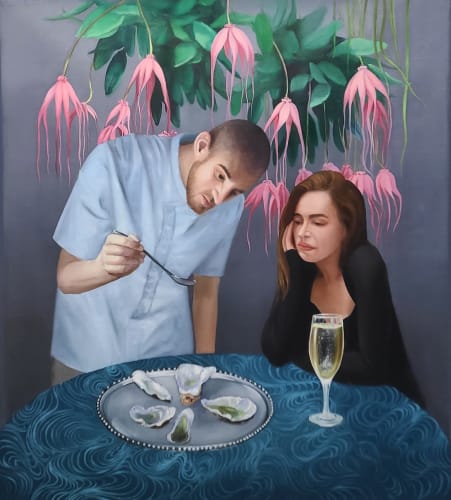Mind Set Art Center is pleased to present in its Project Room the new paintings of Romanian artist Oana Farcas titled Chemistry to Burn Bittersweet Romance." This marks the artist's second solo ex-hibition at the gallery, featuring eight of her latest oil paintings that profoundly depict the crucial role of sensory experiences and synesthesia in shaping emotional memory and personality development. Through everyday activities such as dining, bathing, and conversing, Farcas explores how these tactile behaviors trigger emotions and chemical reactions. The exhibition is scheduled to take place between January 20 and March 2, 2024, with the opening reception at 4 PM on January 20. We extend our heartfelt invitation for you to join us.
Farcas excels in creating an intimate atmosphere in her works through the posture of her characters, the texture of her oil paints, and her use of color. Her paintings are not just a visual feast but a multi-sensory experience. Her fascination with detail and focus on specific objects, such as champagne glasses, shells, ceramics, jewels, and luxurious textiles like velvet, satin, or silk shawls, create a rich and sensuously stimulating environment. These objects not only convey a private history but also sub-tly express eroticism and related fantasies. Her work deepens the viewer's focus on the scene and bodi-ly sensations, leading us into the dreamlike world of the protagonists with vibrant colors and decorative motifs, inviting the audience to engage in complex interpersonal relationships and emotional exchanges through lyrical expression.
Farcas's paintings possess a unique “'magnetism,” drawing viewers into the world within her work. Her technique and style play a key role in creating this effect, encouraging the audience to immerse themselves in her paintings, blurring the lines between canvas and reality, offering a sensory experi-ence beyond visual appreciation. In Chemistry to Burn Bittersweet Romance II, the male and female characters' correspondence and connection in pose, color, and composition reveal a strong bond and intimacy. The female's hand gesture and the shell-like object on the blanket further highlight the rela-tionship between characters and space. Their rhythmically dynamic poses and the stage-like setting that surrounds them hint at deep relationships and rich emotions within a joyful atmosphere. The bright chandelier above especially reflects the inner light and warmth between the two, akin to a theater, con-structing a unique sensory world imagined through objects and space. Farcas explores the process by which consciousness and experience are perceived by the individual through the juxtaposition of dif-ferent elements and compositional techniques, emphasizing the impossibility of complete replication. Urban Mermaid depicts a woman's dreamlike experience in a private space, and a moment of recollec-tion following significant events. Using a collage of reality and dream-like bathing scenes in rich, deep blue hues, Farcas immerses the protagonist in a state of relaxation and reflection on the past. Steam and condensed droplets seem to metaphor a purification ritual, with a brightly colored, contrasting peculiar flower placed in a steamy environment, highlighting not only the contrast of temperatures in the scene but also symbolically the inner contrasting temperatures and emotional states of the character, revealing the complex interplay between different emotional or psychological 'temperatures'.
About the Artist
Oana Farcas, born in Cluj, Romania in 1981, is considered one of the most promising and talented artists of her generation. She has exhibited her work in numerous major cities across Europe and the United States. However, the painterly quality of Farcas's work stands in stark contrast to photo-realism, bringing a warmth and depth that seems uniquely achievable through paint—a richness that harmoniously unites disparate elements, both imagined and real, within a singular, flexible
language. Maurice Merleau-Ponty argued that an artist's ability to see the world is inseparably linked to their ability to navigate it. From this perspective, it is possible to assert that painting is as much an ex-perience of feeling as it is of sight. The artist must imbue her paintings with her own presence, enabling others to also encounter themselves within the artwork. Farcas understands this intrinsic connection, which is what renders her paintings so captivating and alluring.

